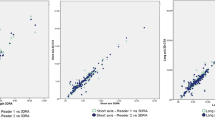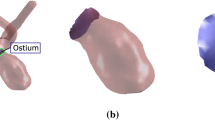Abstract
Purpose
Morphological parameters of intracranial aneurysms (IAs) are well established for rupture risk assessment. However, a manual measurement is error-prone, not reproducible and cumbersome. For an automatic extraction of morphological parameters, a 3D neck curve reconstruction approach to delineate the aneurysm from the parent vessel is required.
Methods
We present a 3D semiautomatic aneurysm neck curve reconstruction for the automatic extraction of morphological parameters which was developed and evaluated with an experienced neuroradiologist. We calculate common parameters from the literature and include two novel angle-based parameters: the characteristic dome point angle and the angle difference of base points.
Results
We applied our method to 100 IAs acquired with rotational angiography in clinical routine. For validation, we compared our approach to manual segmentations yielding highly significant correlations. We analyzed 95 of these datasets regarding rupture state. Statistically significant differences were found in ruptured and unruptured groups for maximum diameter, maximum height, aspect ratio and the characteristic dome point angle. These parameters were also found to statistically significantly correlate with each other.
Conclusions
The new 3D neck curve reconstruction provides robust results for all datasets. The reproducibility depends on the vessel tree centerline and the user input for the initial dome point and parameters characterizing the aneurysm neck region. The characteristic dome point angle as a new metric regarding rupture risk assessment can be extracted. It requires less computational effort than the complete neck curve reconstruction.













Similar content being viewed by others
References
Meng H, Tutino VM, Xiang J, Siddiqui A (2014) High WSS or low WSS? complex interactions of hemodynamics with intracranial aneurysm initiation, growth, and rupture: toward a unifying hypothesis. Am J Neuroradiol 35(7):1254–1262
Weir B, Amidei C, Kongable G, Findlay JM, Kassell NF, Kelly J, Dai L, Karrison TG (2003) The aspect ratio (dome/neck) of ruptured and unruptured aneurysms. J Neurosurg 99(3):447–451
Backes D, Vergouwen MD, Velthuis BK, van der Schaaf IC, Bor ASE, Algra A, Rinkel GJ (2014) Difference in aneurysm characteristics between ruptured and unruptured aneurysms in patients with multiple intracranial aneurysms. Stroke 45(5):1299–1303
Wong SC, Nawawi O, Ramli N, Kadir KAA (2012) Benefits of 3D rotational DSA compared with 2D DSA in the evaluation of intracranial aneurysm. Acad Radiol 19(6):701–707
Dhar S, Tremmel M, Mocco J, Kim M, Yamamoto J, Siddiqui AH, Hopkins LN, Meng H (2008) Morphology parameters for intracranial aneurysm rupture risk assessment. Neurosurgery 63(2):185–196 (discussion 196–7)
Lauric A, Baharoglu MI, Malek AM (2012) Ruptured status discrimination performance of aspect ratio, height/width, and bottleneck factor is highly dependent on aneurysm sizing methodology. Neurosurgery 71(1):38–45
Lv N, Wang C, Karmonik C, Fang Y, Xu J, Yu Y, Cao W, Liu J, Huang Q (2016) Morphological and hemodynamic discriminators for rupture status in posterior communicating artery aneurysms. PLoS ONE 11(2):e0149906
Miura Y, Ishida F, Umeda Y, Tanemura H, Suzuki H, Matsushima S, Shimosaka S, Taki W (2013) Low wall shear stress is independently associated with the rupture status of middle cerebral artery aneurysms. Stroke 44(2):519–521
Raghavan ML, Ma B, Harbaugh RE (2005) Quantified aneurysm shape and rupture risk. J Neurosurg 102(2):355–362
Varble N, Rajabzadeh-Oghaz H, Wang J, Siddiqui A, Meng H, Mowla A (2017) Differences in morphologic and hemodynamic characteristics for “PHASES-based” intracranial aneurysm locations. Am J Neuroradiol 38(11):2105–2110
Xiang J, Natarajan SK, Tremmel M, Ma D, Mocco J, Hopkins LN, Siddiqui AH, Levy EI, Meng H (2011) Hemodynamic-morphologic discriminants for intracranial aneurysm rupture. Stroke 42(1):144–152
Berg P, Saalfeld S, Voß S, Redel T, Preim B, Janiga G, Beuing O (2017) Does the DSA reconstruction kernel affect hemodynamic predictions in intracranial aneurysms? an analysis of geometry and blood flow variations. J Neurointerventional Surg. https://doi.org/10.1136/neurintsurg-2017-012996
Neugebauer M, Lawonn K, Beuing O, Berg P, Janiga G, Preim B (2013) AmniVis—a system for qualitative exploration of near-wall hemodynamics in cerebral aneurysms. Comput Graph Forum 32(3):251–260
Janiga G, Berg P, Beuing O, Neugebauer M, Gasteiger R, Preim B, Rose G, Skalej M, Thévenin D (2013) Recommendations for accurate numerical blood flow simulations of stented intracranial aneurysms. Biomed Eng 58(3):303–314
Saalfeld P, Luz M, Berg P, Preim B, Saalfeld S (2017) Guidelines for quantitative evaluation of medical visualizations on the example of 3D aneurysm surface comparisons. Comput Graph Forum 27(5):347
Glaßer S, Berg P, Voß S, Serowy S, Janiga G, Preim B, Beuing O (2016) From imaging to hemodynamics—how reconstruction kernels influence the blood flow predictions in intracranial aneurysms. Curr Dir Biomed Eng 2(1):163
Glaßer S, Berg P, Neugebauer M, Preim B (2015) Reconstruction of 3D surface meshes for blood flow simulations of intracranial aneurysms. In: Proceeding of the computer- and robot-assisted surgery (CURAC), pp 163–168
Antiga L, Piccinelli M, Botti L, Ene-Iordache B, Remuzzi A, Steinman DA (2008) An image-based modeling framework for patient-specific computational hemodynamics. Med Biol Eng Compu 46(11):1097–1112
Neugebauer M, Diehl V, Skalej M, Preim B (2010) Geometric reconstruction of the ostium of cerebral aneurysms. In: Proceeding of the vision modeling visualization (VMV), pp 307–314
Dijkstra EW (1959) A note on two problems in connexion with graphs. Numer Math 1(1):269–271
Cárdenes R, Larrabide I, San Román L, Frangi AF (2013) Performance assessment of isolation methods for geometrical cerebral aneurysm analysis. Med Biol Eng Compu 51(3):343–352
Ma B, Harbaugh RE, Raghavan ML (2004) Three-dimensional geometrical characterization of cerebral aneurysms. Ann Biomed Eng 32(2):264–273
Karmonik C, Arat A, Benndorf G, Akpek S, Klucznik R, Mawad ME, Strother CM (2004) A technique for improved quantitative characterization of intracranial aneurysms. Am J Neuroradiol 25(7):1158–1161
Jerman T, Pernuš F, Likar B, Špiclin Ž (2015) Computer-aided detection and quantification of intracranial aneurysms. In: Proceeding of the medical image computing and computer-assisted intervention (MICCAI). Lecture notes in computer science, vol 9350, pp 3–10
Cárdenes R, Pozo JM, Bogunovic H, Larrabide I, Frangi AF (2011) Automatic aneurysm neck detection using surface Voronoi diagrams. IEEE Trans Med Imaging 30(10):1863–1876
Hoh BL, Sistrom CL, Firment CS, Fautheree GL, Velat GJ, Whiting JH, Reavey-Cantwell JF, Lewis SB (2007) Bottleneck factor and height-width ratio: association with ruptured aneurysms in patients with multiple cerebral aneurysms. Neurosurgery 61(4):716–723
Cohen J (1988) Statistical power analysis for the behavioral sciences. Erlbaum, New York
Neugebauer M, Lawonn K, Beuing O, Preim B (2013) Automatic generation of anatomic characteristics from cerebral aneurysm surface models. Int J Comput Assist Radiol Surg (JCARS) 8(2):279–289
Berg P, Beuing O (2018) Multiple intracranial aneurysms: a direct hemodynamic comparison between ruptured and unruptured vessel malformations. Int J Comput Assist Radiol Surg (JCARS) 13(1):83–93
Cebral JR, Mut F, Weir J, Putman C (2011) Quantitative characterization of the hemodynamic environment in ruptured and unruptured brain aneurysms. Am J Neuroradiol (AJNR) 32(1):145–151
Acknowledgements
The work was funded by the Federal Ministry of Education and Research within the Forschungscampus STIMULATE under Grant No. “13GW0095A.”
Author information
Authors and Affiliations
Corresponding author
Ethics declarations
Conflict of interest
The authors declare that they have no conflict of interest.
Ethical approval
All procedures performed in studies involving human participants were in accordance with the ethical standards of the institutional and/or national research committee and with the 1964 Declaration of Helsinki and its later amendments or comparable ethical standards. For this type of study, formal consent is not required.
Informed consent
Informed consent was obtained from all individual participants included in the study.
Rights and permissions
About this article
Cite this article
Saalfeld, S., Berg, P., Niemann, A. et al. Semiautomatic neck curve reconstruction for intracranial aneurysm rupture risk assessment based on morphological parameters. Int J CARS 13, 1781–1793 (2018). https://doi.org/10.1007/s11548-018-1848-x
Received:
Accepted:
Published:
Issue Date:
DOI: https://doi.org/10.1007/s11548-018-1848-x




